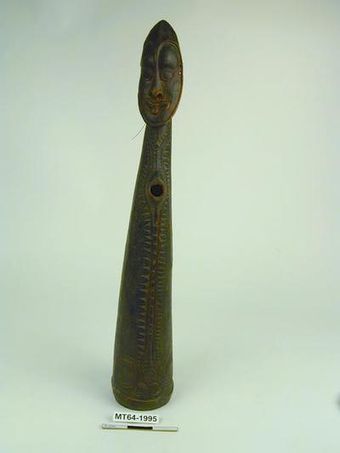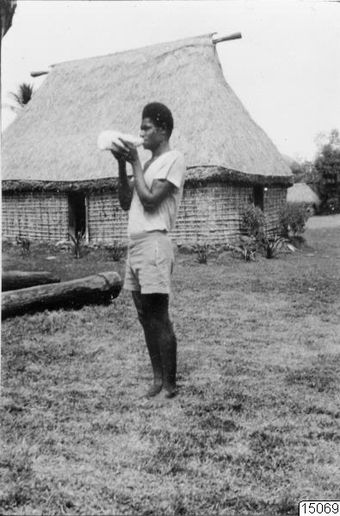Tepuŋ ‘Side-blown trumpet’
- Description:
- This string figure represents tepuŋ ‘a side-blown trumpet’. Such a trumpet can either be made of bamboo or of wood, or can even be a conch-shell (the Awiakay used to have a shell trumpet, probably obtained through trading or by one of the men bringing it back from their work on a plantation in the Rabaul area, but it was broken, and there are currently none in the village). The name tepuŋ is used of the instrument based on how it is played, rather than on what it is made from. That is why there is slight confusion when the Awiakay translate tepuŋ into Tok Pisin: sometimes it is called mambu 'bamboo' (like the bamboo flutes) and sometimes kina wusil (Among the Awiakay, the TP word kina, originally referring to large mother-of-pearl shell, is extended to all shells, and TP wusil 'whistle' is just an approximate translation of Awiakay upiak- which refers to all types of blowing (into something, including an instrument). Tepuŋ is side-blown, because there is a hole on the side of the instrument (rather than at the end) into which the player blows and vibrates his lips. This vibrating of lips makes it a trumpet and not a flute where the player would direct a stream of air against an edge (Don Niles, personal communication by email, 5 June 2020). Although tepuŋ is always played by men, there are no prohibitions on women and girls doing it as part of the make-believe of string figure-making. In the Middle Sepik large wooden side-blown trumpets used to be blown for fighting, or head-hunting or both. For a variety of side-blown trumpets in Papua New Guinea, see Niles (in prep.). In the video recording of this string figure we can see that when Munbaŋgoapik first starts to blow (1:01) she makes a higher pitch sound and then giggles, and then repeats this, giggling again. But when she stops giggling (1:10), she makes a lower pitch sound a few times. That lower pitch sounds much more like a trumpet, So, this girl actually does a fine job, indicating that even women who do not play instruments, know exactly what they should sound like. Of course, she eventually starts giggling again, but every time she goes back to making the sound it is the lower, sustained sound, typical of a trumpet. It is much harder to get different pitches out of such instruments when they are played as a trumpet, than that can be done with a flute (Don Niles, pers. com. by email, 5 June 2020). Images: 02: tepuŋ ‘side-blown trumpet’, final design 03: Darja Munbaŋgoapik demonstrating blowing into tepuŋ ‘side-blown trumpet’ 04: Justin Taypay with a wooden tepuŋ ‘side-blown trumpet’ 04: Stenli Pamuapan with a bamboo tepuŋ ‘side-blown trumpet’ Niles, Don. In preparation. Visual Guide to the Musical Instruments of Papua New Guinea. . Language as given: Awiakay. You can access this item at the PARADISEC website. You will need to sign up or sign in first.
- Format:
- MovingImage
- Collections:
- PARADISEC Catalog
- Contributors:
- Darja Hoenigman
- Content partner:
- PARADISEC
- Availability:
- Not specified
-
Copyright status: All rights reservedFind out more about what you are able to do with this itemThis item is all rights reserved, with means you'll have to get permission from PARADISEC before using it. For more information, please see our use and reuse page.More informationPARADISEC has this to say about the rights status of this item:
Open (subject to agreeing to PDSC access conditions)
What can I do with this item?Non-infringing useNZ copyright law does not prevent every use of a copyright work, and this item may be hosted by an international institute or organisation. You should consider what you can and cannot do with a copyright work.No sharingYou may not copy and/or share this item with others without further permission. This includes posting it on your blog, using it in a presentation, or any other public use.No modifyingYou are not allowed to adapt or remix this item into any other works.No commercial useYou may not use this item commercially.
Related items
Welcome and warm Pasifik greetings
The information on this site has been gathered from our content partners.
The names, terms, and labels that we present on the site may contain images or voices of deceased persons and may also reflect the bias, norms, and perspective of the period of time in which they were created. We accept that these may not be appropriate today.
If you have any concerns or questions about an item, please contact us.

